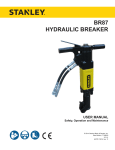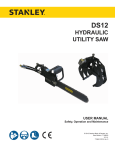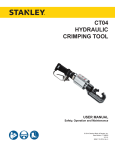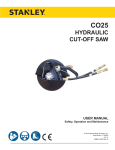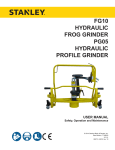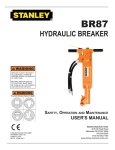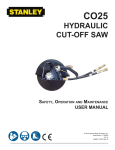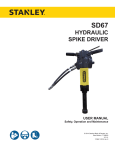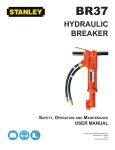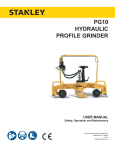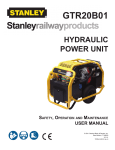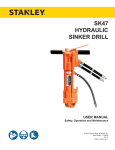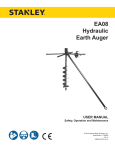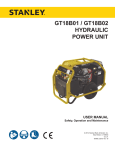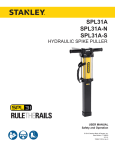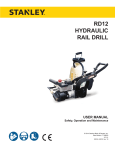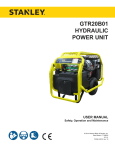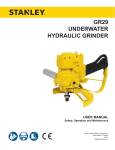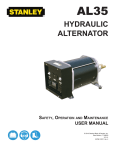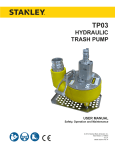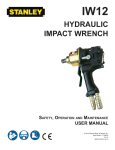Download BR87 User Manual 6-2015 V15
Transcript
BR87 HYDRAULIC BREAKER USER MANUAL Safety, Operation and Maintenance © 2014 Stanley Black & Decker, Inc. New Britain, CT 06053 U.S.A. 65778 6/2015 Ver. 15 DECLARATION OF CONFORMITY DECLARATION OF CONFORMITY ÜBEREINSTIMMUNGS-ERKLARUNG DECLARATION DE CONFORMITE CEE DECLARACION DE CONFORMIDAD DICHIARAZIONE DI CONFORMITA Hydraulic Tools ______________________________________________________________________ I, the undersigned: Ich, der Unterzeichnende: Je soussigné: El abajo firmante: lo sottoscritto: Weisbeck, Andy Surname and First names/Familiennname und Vornamen/Nom et prénom/Nombre y apellido/Cognome e nome hereby declare that the equipment specified hereunder: bestätige hiermit, daß erklaren Produkt genannten Werk oder Gerät: déclare que l’équipement visé ci-dessous: Por la presente declaro que el equipo se especifica a continuación: Dichiaro che le apparecchiature specificate di seguito: 1. Category: Kategorie: Catégorie: Categoria: Categoria: Hydraulic Hand Held Concrete Breaker 2. Make/Marke/Marque/Marca/Marca Stanley 3. Type/Typ/Type/Tipo/Tipo: 4. Serial number of equipment: Seriennummer des Geräts: Numéro de série de l’équipement: Numero de serie del equipo: Matricola dell´attrezzatura: 5. Mass/Masse/Masse/Masa/Massa BR8713201, BR8717201, BR87320 BR8713201 BR8717201 BR87320 All All Serial # 031312004 and above 38 kg Has been manufactured in conformity with Wurde hergestellt in Übereinstimmung mit Est fabriqué conformément Ha sido fabricado de acuerdo con E’ stata costruita in conformitá con Directive/Standards Richtlinie/Standards Directives/Normes Directriz/Los Normas Direttiva/Norme No. Nr Numéro No n. Approved body Prüfung durch Organisme agréé Aprobado Collaudato ISO Noise Directive 11148-4:2010 2000/14/EC:2005 Machinery Directive ISO 2006/42/EC:2006 28927-10:2011 Self AkustikNet (Notified body ID 1585) Bagsvard Hovedgade 141, 2880 Bagsvard, Denmark Certificate #863/2011/005 Self Self 6. Special Provisions: None Spezielle Bestimmungen: Dispositions particulières: Provisiones especiales: Disposizioni speciali: 8. Representative in the Union: Patrick Vervier, Stanley Dubuis 17-19, rue Jules Berthonneau-BP 3406 41034 Blois Cedex, France. Vertreter in der Union/Représentant dans l’union/Representante en la Union/Rappresentante presso l’Unione 7. Measurements: Messungen Mesures Mediciones Misurazioni Done at/Ort/Fait à/Dado en/Fatto a Stanley Hydraulic Tools, Milwaukie, Oregon USA Signature/Unterschrift/Signature/Firma/Firma Position/Position/Fonction/Cargo/Posizione 2 ► BR87 User Manual Director of Product Development Measured Sound Power Level 105 LwA Guaranteed Sound Power Level 106 LwA Measured in accordance to Directive 2000/14/EC, Annex III, Part B, No 10, m ≥ 30 Date/Datum/le/Fecha/Data 1-30-12 TABLE OF CONTENTS DECLARATION OF CONFORMITY...........................................................................................................................2 SAFETY SYMBOLS...................................................................................................................................................4 SAFETY PRECAUTIONS...........................................................................................................................................5 TOOL STICKERS & TAGS.........................................................................................................................................7 HOSE TYPES.............................................................................................................................................................8 HOSE RECOMMENDATIONS...................................................................................................................................9 FIGURE 1. TYPICAL HOSE CONNECTIONS........................................................................................................9 HTMA REQUIREMENTS..........................................................................................................................................10 OPERATION............................................................................................................................................................. 11 TOOL PROTECTION & CARE.................................................................................................................................12 TROUBLESHOOTING.............................................................................................................................................13 CHARGING THE ACCUMULATOR..........................................................................................................................14 FIGURE 2. CHARGING THE ACCUMULATOR....................................................................................................15 SPECIFICATIONS....................................................................................................................................................16 ACCESSORIES.......................................................................................................................................................17 SERVICE TOOLS.....................................................................................................................................................17 BR87 PARTS ILLUSTRATION.................................................................................................................................18 BR87 PARTS LIST...................................................................................................................................................20 UNDERWATER TOOLS DEPTH GUIDELINE..........................................................................................................21 IMPORTANT To fill out a Product Warranty Validation form, and for information on your warranty, visit Stanleyhydraulics.com and select the Company tab, Warranty. (NOTE: The warranty Validation record must be submitted to validate the warranty). SERVICING: This manual contains safety, operation, and routine maintenance instructions. Stanley Hydraulic Tools recommends that servicing of hydraulic tools, other than routine maintenance, must be performed by an authorized and certified dealer. Please read the following warning. WARNING SERIOUS INJURY OR DEATH COULD RESULT FROM THE IMPROPER REPAIR OR SERVICE OF THIS TOOL. REPAIRS AND / OR SERVICE TO THIS TOOL MUST ONLY BE DONE BY AN AUTHORIZED AND CERTIFIED DEALER. For the nearest authorized and certified dealer, call Stanley Hydraulic Tools at the number listed on the back of this manual and ask for a Customer Service Representative. BR87 User Manual ◄ 3 SAFETY SYMBOLS Safety symbols and signal words, as shown below, are used to emphasize all operator, maintenance and repair actions which, if not strictly followed, could result in a life-threatening situation, bodily injury or damage to equipment. This is the safety alert symbol. It is used to alert you to potential personal injury hazards. Obey all safety messages that follow this symbol to avoid possible injury or death. DANGER This safety alert and signal word indicate an imminently hazardous situation which, if not avoided, will result in death or serious injury. WARNING This safety alert and signal word indicate a potentially hazardous situation which, if not avoided, could result in death or serious injury. CAUTION This safety alert and signal word indicate a potentially hazardous situation which, if not avoided, could result in death or serious injury. CAUTION This signal word indicates a potentially hazardous situation which, if not avoided, may result in property damage. NOTICE This signal word indicates a situation which, if not avoided, will result in damage to the equipment. IMPORTANT This signal word indicates a situation which, if not avoided, may result in damage to the equipment. Always observe safety symbols. They are included for your safety and for the protection of the tool. LOCAL SAFETY REGULATIONS Enter any local safety regulations here. Keep these instructions in an area accessible to the operator and maintenance personnel. 4 ► BR87 User Manual SAFETY PRECAUTIONS Tool operators and maintenance personnel must always comply with the safety precautions given in this manual and on the stickers and tags attached to the tool and hose. These safety precautions are given for your safety. Review them carefully before operating the tool and before performing general maintenance or repairs. Supervising personnel should develop additional precautions relating to the specific work area and local safety regulations. If so, place the added precautions in the space provided in this manual. The BR87 Hydraulic Breaker will provide safe and dependable service if operated in accordance with the instructions given in this manual. Read and understand this manual and any stickers and tags attached to the tool and hoses before operation. Failure to do so could result in personal injury or equipment damage. • Operator must start in a work area without bystanders. The operator must be familiar with all prohibited work areas such as excessive slopes and dangerous terrain conditions. • Establish a training program for all operators to ensure safe operation. • Do not operate the tool unless thoroughly trained or under the supervision of an instructor. • Always wear safety equipment such as goggles, gloves, ear, head, and breathing protection, and safety shoes at all times when operating the tool. • Do not inspect, carry or clean the tool while the hydraulic power source is connected. Accidental engagement of the tool can cause serious injury. • Supply hoses must have a minimum working pressure rating of 2500 psi/175 bar. • Be sure all hose connections are tight. • The hydraulic circuit control valve must be in the “OFF” position when coupling or uncoupling the tool. Wipe all couplers clean before connecting. Use only lint-free cloths. Failure to do so may result in damage to the quick couplers and cause overheating of the hydraulic system. • Do not operate the tool at oil temperatures above 140 °F/60 °C. Operation at higher oil temperatures can cause operator discomfort and may damage the tool. Never come in contact with the tool bit, the bit can get hot. • Do not operate a damaged, improperly adjusted, or incompletely assembled tool. • Do not weld, cut with an acetylene torch, or hardface the tool bit. • To avoid personal injury or equipment damage, all tool repair, maintenance and service must only be performed by authorized and properly trained personnel. • Do not exceed the rated limits of the tool or use the tool for applications beyond its design capacity. • Always keep critical tool markings, such as labels and warning stickers legible. • Always replace parts with replacement parts recommended by Stanley Hydraulic Tools. • Warning: Use of this tool on certain materials during demolition could generate dust potentially containing a variety of hazardous substances such as asbestos, silica or lead. Inhalation of dust containing these or other hazardous substances could result in serious injury, cancer or death. Protect yourself and those around you. Research and understand the materials you are cutting. Follow correct safety procedures and comply with all applicable national, state or provisional health and safety regulations relating to them, including, if appropriate arranging for the safe disposal of the materials by a qualified person. BR87 User Manual ◄ 5 SAFETY PRECAUTIONS • Check fastener tightness often and before each use daily. • Take caution when changing a tool bit, tool bits can get very hot. • Never operate the tool if you cannot be sure that underground utilities are not present. • • Do not wear loose fitting clothing when operating the tool. Never use the tool in an explosive atmosphere, sparks from the breaking process could ignite explosive gas. • • Warning: Hydraulic fluid under pressure could cause skin injection injury. If you are injured by hydraulic fluid, get medical attention immediately. Use proper lifting techniques when handling the tool, get help from a co-worker and do not over-reach. • Use proper protection from falling or flying debris, keep bystanders at a safe distance. • Keep all body parts away from the working tool. • • When handling material or the tool bit, wear your (PPE) Personal Protection Equipment. • Be observant of the hydraulic hoses lying about the work area, they can be a tripping hazard. Do not exceed the rated flow and pressure. See Specifications in this manual for correct flow rate and pressure rating. Rapid failure of the internal seals may result. • Always de-energize the hydraulic system when changing a tool bit. 6 ► BR87 User Manual TOOL STICKERS & TAGS BR87 BREAKER These numbers are for example only and may not relate to your model of breaker, see part number below for name tag sticker that fits your model breaker. 11207 Circuit Type C Decal 28409 Composite Decal 74673 BR87 Name Tag Decal 11208 Hex Shank Decal 72786 Guarnteed Sound Power Level Decal 74832 Stanley Logo 10180 Caution Decal D A N G E R 28322 CE Decal 1. BEFORE USING HOSE LABELED AND CERTIFIED AS NONCONDUCTIVE ON OR NEAR ELECTRIC LINES BE SURE THE HOSE IS MAINTAINED AS NON-CONDUCTIVE. THE HOSE SHOULD BE REGULARLY TESTED FOR ELECTRIC CURRENT LEAKAGE IN ACCORDANCE WITH YOUR SAFETY DEPARTMENT INSTRUCTIONS. 2. The safety tag (P/N 15875) at right is attached to the tool when shipped from the factory. Read and understand the safety instructions listed on this tag before removal. We suggest you retain this tag and attach it to the tool when not in use. FAILURE TO USE HYDRAULIC HOSE LABELED AND CERTIFIED AS NON-CONDUCTIVE WHEN USING HYDRAULIC TOOLS ON OR NEAR ELECTRICAL LINES MAY RESULT IN DEATH OR SERIOUS INJURY. A HYDRAULIC LEAK OR BURST MAY CAUSE OIL INJECTION INTO THE BODY OR CAUSE OTHER SEVERE PERSONAL INJURY. A. DO NOT EXCEED SPECIFIED FLOW AND PRESSURE FOR THIS TOOL. EXCESS FLOW OR PRESSURE MAY CAUSE A LEAK OR BURST. B. DO NOT EXCEED RATED WORKING PRESSURE OF HYDRAULIC HOSE USED WITH THIS TOOL. EXCESS PRESSURE MAY CAUSE A LEAK OR BURST. C. CHECK TOOL HOSE COUPLERS AND CONNECTORS DAILY FOR LEAKS. DO NOT FEEL FOR LEAKS WITH YOUR HANDS. CONTACT WITH A LEAK MAY RESULT IN SEVERE PERSONAL INJURY. D A N G E R D. DO NOT LIFT OR CARRY TOOL BY THE HOSES. DO NOT ABUSE HOSE. DO NOT USE KINKED, TORN OR DAMAGED HOSE. 3. MAKE SURE HYDRAULIC HOSES ARE PROPERLY CONNECTED TO THE TOOL BEFORE PRESSURING SYSTEM. SYSTEM PRESSURE HOSE MUST ALWAYS BE CONNECTED TO TOOL “IN” PORT. SYSTEM RETURN HOSE MUST ALWAYS BE CONNECTED TO TOOL “OUT” PORT. REVERSING CONNECTIONS MAY CAUSE REVERSE TOOL OPERATION WHICH CAN RESULT IN SEVERE PERSONAL INJURY. 4. DO NOT CONNECT OPEN-CENTER TOOLS TO CLOSEDCENTER HYDRAULIC SYSTEMS. THIS MAY RESULT IN LOSS OF OTHER HYDRAULIC FUNCTIONS POWERED BY THE SAME SYSTEM AND/OR SEVERE PERSONAL INJURY. 5. BYSTANDERS MAY BE INJURED IN YOUR WORK AREA. KEEP BYSTANDERS CLEAR OF YOUR WORK AREA. 6. WEAR HEARING, EYE, FOOT, HAND AND HEAD PROTECTION. 7. TO AVOID PERSONAL INJURY OR EQUIPMENT DAMAGE, ALL TOOL REPAIR MAINTENANCE AND SERVICE MUST ONLY BE PERFORMED BY AUTHORIZED AND PROPERLY TRAINED PERSONNEL. I M P O R T A N T I M P O R T A N T READ OPERATION MANUAL AND SAFETY INSTRUCTIONS FOR THIS TOOL BEFORE USING IT. READ OPERATION MANUAL AND SAFETY INSTRUCTIONS FOR THIS TOOL BEFORE USING IT. USE ONLY PARTS AND REPAIR PROCEDURES APPROVED BY STANLEY AND DESCRIBED IN THE OPERATION MANUAL. USE ONLY PARTS AND REPAIR PROCEDURES APPROVED BY STANLEY AND DESCRIBED IN THE OPERATION MANUAL. TAG TO BE REMOVED ONLY BY TOOL OPERATOR. TAG TO BE REMOVED ONLY BY TOOL OPERATOR. SEE OTHER SIDE SEE OTHER SIDE SAFETY TAG P/N 15875 (Shown smaller then actual size) BR87 User Manual ◄ 7 HOSE TYPES The rated working pressure of the hydraulic hose must be equal to or higher than the relief valve setting on the hydraulic system. There are three types of hydraulic hose that meet this requirement and are authorized for use with Stanley Hydraulic Tools. They are: Certified non-conductive — constructed of thermoplastic or synthetic rubber inner tube, synthetic fiber braid reinforcement, and weather resistant thermoplastic or synthetic rubber cover. Hose labeled certified nonconductive is the only hose authorized for use near electrical conductors. Wire-braided (conductive) — constructed of synthetic rubber inner tube, single or double wire braid reinforcement, and weather resistant synthetic rubber cover. This hose is conductive and must never be used near electrical conductors. Fabric-braided (not certified or labeled non-conductive) — constructed of thermoplastic or synthetic rubber inner tube, synthetic fiber braid reinforcement, and weather resistant thermoplastic or synthetic rubber cover. This hose is not certified non-conductive and must never be used near electrical conductors. HOSE SAFETY TAGS To help ensure your safety, the following DANGER tags are attached to all hose purchased from Stanley Hydraulic Tools. DO NOT REMOVE THESE TAGS. If the information on a tag is illegible because of wear or damage, replace the tag immediately. A new tag may be obtained from your Stanley Distributor. D A N G E R D A N G E R 1. FAILURE TO USE HYDRAULIC HOSE LABELED AND CERTIFIED AS NON-CONDUCTIVE WHEN USING HYDRAULIC TOOLS ON OR NEAR ELECTRIC LINES MAY RESULT IN DEATH OR SERIOUS INJURY. FOR PROPER AND SAFE OPERATION MAKE SURE THAT YOU HAVE BEEN PROPERLY TRAINED IN CORRECT PROCEDURES REQUIRED FOR WORK ON OR AROUND ELECTRIC LINES. 2. BEFORE USING HYDRAULIC HOSE LABELED AND CERTIFIED AS NON-CONDUCTIVE ON OR NEAR ELECTRIC LINES. WIPE THE ENTIRE LENGTH OF THE HOSE AND FITTING WITH A CLEAN DRY ABSORBENT CLOTH TO REMOVE DIRT AND MOISTURE AND TEST HOSE FOR MAXIMUM ALLOWABLE CURRENT LEAKAGE IN ACCORDANCE WITH SAFETY DEPARTMENT INSTRUCTIONS. 3. DO NOT EXCEED HOSE WORKING PRESSURE OR ABUSE HOSE. IMPROPER USE OR HANDLING OF HOSE COULD RESULT IN BURST OR OTHER HOSE FAILURE. KEEP HOSE AS FAR AWAY AS POSSIBLE FROM BODY AND DO NOT PERMIT DIRECT CONTACT DURING USE. CONTACT AT THE BURST CAN CAUSE BODILY INJECTION AND SEVERE PERSONAL INJURY. 4. HANDLE AND ROUTE HOSE CAREFULLY TO AVOID KINKING, ABRASION, CUTTING, OR CONTACT WITH HIGH TEMPERATURE SURFACES. DO NOT USE IF KINKED. DO NOT USE HOSE TO PULL OR LIFT TOOLS, POWER UNITS, ETC. 5. CHECK ENTIRE HOSE FOR CUTS CRACKS LEAKS ABRASIONS, BULGES, OR DAMAGE TO COUPLINGS IF ANY OF THESE CONDITIONS EXIST, REPLACE THE HOSE IMMEDIATELY. NEVER USE TAPE OR ANY DEVICE TO ATTEMPT TO MEND THE HOSE. 6. AFTER EACH USE STORE IN A CLEAN DRY AREA. SEE OTHER SIDE SIDE 1 SEE OTHER SIDE (Shown smaller than actual size) DO NOT REMOVE THIS TAG DO NOT REMOVE THIS TAG THE TAG SHOWN BELOW IS ATTACHED TO “CERTIFIED NON-CONDUCTIVE” HOSE SIDE 2 D A N G E R D A N G E R 1. DO NOT USE THIS HYDRAULIC HOSE ON OR NEAR ELECTRIC LINES. THIS HOSE IS NOT LABELED OR CERTIFIED AS NON-CONDUCTIVE. USING THIS HOSE ON OR NEAR ELECTRICAL LINES MAY RESULT IN DEATH OR SERIOUS INJURY. 5. CHECK ENTIRE HOSE FOR CUTS CRACKS LEAKS ABRASIONS, BULGES, OR DAMAGE TO COUPLINGS IF ANY OF THESE CONDITIONS EXIST, REPLACE THE HOSE IMMEDIATELY. NEVER USE TAPE OR ANY DEVICE TO ATTEMPT TO MEND THE HOSE. 2. FOR PROPER AND SAFE OPERATION MAKE SURE THAT YOU HAVE BEEN PROPERLY TRAINED IN CORRECT PROCEDURES REQUIRED FOR WORK ON OR AROUND ELECTRIC LINES. 6. AFTER EACH USE STORE IN A CLEAN DRY AREA. 3. DO NOT EXCEED HOSE WORKING PRESSURE OR ABUSE HOSE. IMPROPER USE OR HANDLING OF HOSE COULD RESULT IN BURST OR OTHER HOSE FAILURE. KEEP HOSE AS FAR AWAY AS POSSIBLE FROM BODY AND DO NOT PERMIT DIRECT CONTACT DURING USE. CONTACT AT THE BURST CAN CAUSE BODILY INJECTION AND SEVERE PERSONAL INJURY. 4. HANDLE AND ROUTE HOSE CAREFULLY TO AVOID KINKING, CUTTING, OR CONTACT WITH HIGH TEMPERATURE SURFACES. DO NOT USE IF KINKED. DO NOT USE HOSE TO PULL OR LIFT TOOLS, POWER UNITS, ETC. SEE OTHER SIDE SEE OTHER SIDE SIDE 1 SIDE 2 (Shown smaller than actual size) 8 ► BR87 User Manual DO NOT REMOVE THIS TAG DO NOT REMOVE THIS TAG THE TAG SHOWN BELOW IS ATTACHED TO “CONDUCTIVE” HOSE. All hydraulic hose must meet or exceed specifications as set forth by SAE J517. All hydraulic hose must have at least a rated minimum working pressure equal to the maximum hydraulic system relief valve setting. This chart is intended to be used for hydraulic tool applications only based on Stanley Hydraulic Tools tool operating requirements and should not be used for any other applications. The chart to the right shows recommended minimum hose diameters for various hose lengths based on gallons per minute (gpm)/ liters per minute (lpm). These recommendations are intended to keep return line pressure (back pressure) to a minimum acceptable level to ensure maximum tool performance. Tool to Hydraulic Circuit Hose Recommendations 15-34 MM Inside Diameter INCH USE (Press/Return) PSI up to 10 up to 3 3/8 10 Both 2250 49-60 13-16 FLOW >>> RETURN <<< FLOW PRESSURE 26-100 up to 25 100-200 51-100 up to 50 100-300 51-100 up to 50 26-100 up to 25 8-30 up to 8 30-60 15-30 up to 15 30-90 15-30 up to 15 7.5-30 up to 7.5 Figure 1. Typical Hose Connections 49-60 38-49 10-13 13-16 19-40 5-10.5 38-49 19-40 5-10.5 10-13 19-40 5-10.5 38-49 15-23 10-13 15-23 4-6 19 25.4 16 19 19 25.4 5/8 3/4 3/4 1 19 3/4 1 16 3/4 16 19 3/4 5/8 16 5/8 5/8 16 13 13 10 5/8 1/2 1/2 3/8 Return Pressure Return Pressure Return Pressure Return Pressure Both Return Pressure Both Both Both Both 2500 2500 2500 2500 2500 2500 2500 2500 2500 2500 2500 2500 2500 2500 2500 175 175 175 175 175 175 175 175 175 175 175 175 175 175 175 155 BAR Min. Working Pressure Certified Non-Conductive Hose - Fiber Braid - for Utility Bucket Trucks METERS Hose Lengths FEET Conductive Hose - Wire Braid or Fiber Braid -DO NOT USE NEAR ELECTRICAL CONDUCTORS 4-6 4-9 LPM Oil Flow GPM HOSE RECOMMENDATIONS BR87 User Manual ◄ 9 HTMA / EHTMA REQUIREMENTS HTMA / EHTMA REQUIREMENTS HTMA HYDRAULIC SYSTEM REQUIREMENTS TYPE I Nominal Operating Pressure (at the power supply outlet) 4-6 gpm (15-23 lpm) 1500 psi (103 bar) TOOL TYPE TYPE II TYPE RR 7-9 gpm (26-34 lpm) 1500 psi (103 bar) 9-10.5 gpm (34-40 lpm) 1500 psi (103 bar) System relief valve setting (at the power supply outlet) 2100-2250 psi (145-155 bar) 2100-2250 psi (145-155 bar) 2200-2300 psi (152-159 bar) 2100-2250 psi (145-155 bar) Maximum back pressure (at tool end of the return hose) 250 psi (17 bar) 250 psi (17 bar) 250 psi (17 bar) 250 psi (17 bar) Measured at a max. fluid viscosity of: (at min. operating temperature) 400 ssu* 400 ssu* 400 ssu* 400 ssu* (82 centistokes) (82 centistokes) (82 centistokes) (82 centistokes) Temperature: Sufficient heat rejection capacity to limit max. fluid temperature to: (at max. expected ambient temperature) 140° F (60° C) Flow Range 140° F (60° C) 140° F (60° C) TYPE III 11-13 gpm (42-49 lpm) 1500 psi (103 bar) 140° F (60° C) 3 hp 5 hp 6 hp 7 hp Min. cooling capacity at a temperature (2.24 kW) (3.73 kW) (5.22 kW) (4.47 kW) difference of between ambient and fluid 40° F 40° F 40° F 40° F temps (22° C) (22° C) (22° C) (22° C) NOTE: Do not operate the tool at oil temperatures above 140° F (60° C). Operation at higher temperatures can cause operator discomfort at the tool. Filter Min. full-flow filtration Sized for flow of at least: (For cold temp. startup and max. dirt-holding capacity) 25 microns 30 gpm (114 lpm) Hydraulic fluid Petroleum based (premium grade, anti-wear, non-conductive) Viscosity (at min. and max. operating temps) 100-400 ssu* 25 microns 30 gpm (114 lpm) 25 microns 30 gpm (114 lpm) 100-400 ssu* 100-400 ssu* (20-82 centistokes) 25 microns 30 gpm (114 lpm) 100-400 ssu* NOTE: When choosing hydraulic fluid, the expected oil temperature extremes that will be experienced in service determine the most suitable temperature viscosity characteristics. Hydraulic fluids with a viscosity index over 140 will meet the requirements over a wide range of operating temperatures. *SSU = Saybolt Seconds Universal EHTMA HYDRAULIC SYSTEM REQUIREMENTS CLASSIFICATION B C D Nominal Operating Pressure (at the power supply outlet) 3.5-4.3 gpm (13.5-16.5 lpm) 1870 psi (129 bar) 4.7-5.8 gpm (18-22 lpm) 1500 psi (103 bar) 7.1-8.7 gpm (27-33 lpm) 1500 psi (103 bar) 9.5-11.6 gpm (36-44 lpm) 1500 psi (103 bar) 11.8-14.5 gpm (45-55 lpm) 1500 psi (103 bar) System relief valve setting (at the power supply outlet) 2495 psi (172 bar) 2000 psi (138 bar) 2000 psi (138 bar) 2000 psi (138 bar) 2000 psi (138 bar) Flow Range NOTE: These are general hydraulic system requirements. See tool specification page for tool specific requirements 10 ► BR87 User Manual OPERATION The recommended hose size is .500 inch/12 mm I.D. up to 50 ft/15 m long and .625 inch/16 mm I.D. minimum up to 100 ft/30 m. PRE-OPERATION PROCEDURES CHECK POWER SOURCE 1. Using a calibrated flowmeter and pressure gauge, check that the hydraulic power source develops a flow of 7-9 gpm/26-34 lpm at 1500-2000 psi/105140 bar. 2. Make certain the hydraulic power source is equipped with a relief valve set to open at 2100-2250 psi/145155 bar maximum. INSTALL TOOL BIT 1. Rotate the latch on the breaker foot downward (pointing away from the tool). 2. Insert the tool bit into the foot and pull the latch up to lock the tool bit in place. CONNECT HOSES 1. Wipe all hose couplers with a clean, lint-free cloth before making connections. 2. Connect the hoses from the hydraulic power source to the tool fittings or quick disconnects. It is a good practice to connect return hoses first and disconnect them last to minimize or avoid trapped pressure within the tool. 3. Observe flow indicators stamped on hose couplers to ensure that fluid flow is in the proper direction. The female coupler on the tool hose is the inlet coupler. 4. Move the hydraulic circuit control valve to the ON position to operate the tool. NOTE: If uncoupled hoses are left in the sun, pressure increase within the hoses may make them difficult to connect. When possible, connect the free ends of the hoses together. NOTE: Partially depressing the trigger allows the tool to run at slow speed. Slow-speed operation permits easier starting of the tool bit into the work surface. 5. To start, break an opening (hole) in the center of the surface. After making a hole, break portions of the material into the original opening. For best productivity, the breaking should be done around the original hole. The size of the broken material will vary with the strength and thickness of the base material and the amount of any reinforcement wire or rebar. Harder material or more reinforcing wire or rebar will require taking smaller bites. To determine the most effective bite, start with 2 in. / 50 mm or smaller bites. Bites can then be gradually increased until the broken piece becomes too large, requiring increased time to break off the piece. Sticking of the tool bit occurs when too large a bite is being taken and the tool bit hammers into the material without the material fracturing. This causes the tool bit to become trapped in the surrounding material. 6. The underwater model requires preventative maintenance after each day’s use underwater and prior to being placed in storage. See the General Service Notes section in this manual for this maintenance procedure. COLD WEATHER OPERATION If the breaker is to be used during cold weather, preheat the hydraulic fluid at low engine speed. When using the normally recommended fluid, fluid temperature should be at or above 50 °F/10 °C (400 ssu/82 centistokes) before use. Damage to the hydraulic system or breaker can result from use with fluid that is too viscous or thick. OPERATION PROCEDURES 1. Observe all safety precautions. 2. Install the appropriate tool bit for the job. 3. Place the bit firmly on the surface to be broken. 4. Squeeze the trigger to start the breaker. Adequate down pressure is very important. When the tool bit breaks through the obstruction or becomes bound, release the trigger and reposition the tool bit. BR87 User Manual ◄ 11 TOOL PROTECTION & CARE NOTICE In addition to the Safety Precautions found in this manual, observe the following for equipment protection and care. • Make sure all couplers are wiped clean before connection. • Always keep critical tool markings, such as warning stickers and tags legible. • The hydraulic circuit control valve must be in the “OFF” position when coupling or uncoupling hydraulic tools. Failure to do so may result in damage to the quick couples and cause overheating of the hydraulic system. • Do not force a small breaker to do the job of a large breaker. • • Always store the tool in a clean dry space, safe from damage or pilferage. Keep tool bit sharp for maximum breaker performance. Make sure that tool bits are not chipped or rounded on the striking end. • • Make sure the circuit PRESSURE hose (with male quick disconnect) is connected to the “IN” port. The circuit RETURN hose (with female quick disconnect) is connected to the opposite port. Do not reverse circuit flow. This can cause damage to internal seals. Never operate a breaker without a tool bit or without holding it against the work surface. This puts excessive strain on the breaker foot. • Tool repair should be performed by experienced personnel only. • Make certain that the recommended relief valves are installed in the pressure side of the system. • Do not use the tool for applications for which it was not intended. • Always replace hoses, couplings and other parts with replacement parts recommended by Stanley Hydraulic Tools. Supply hoses must have a minimum working pressure rating of 2500 psi/172 bar. • Do not exceed the rated flow and pressure. See Specifications in this manual for correct flow rate and pressure rating. Rapid failure of the internal seals may result. 12 ► BR87 User Manual TROUBLESHOOTING PROBLEM Tool does not run. CAUSE REMEDY Power unit not functioning. Check power unit for proper flow and pressure (7–9 gpm/26–34 lpm, 1500-2000 psi/105–140 bar. Couplers or hoses blocked. Remove restriction. Pressure and return line hoses reversed at ports. Be sure hoses are connected to their proper ports. Mechanical failure of piston or automatic valve. Disassemble breaker and inspect for damaged parts. Power unit not functioning. Check power unit for proper flow and pressure (7–9 gpm/26–34 lpm, 1500–2000 psi/105–140 bar. Couplers or hoses blocked. Remove restriction. Low accumulator charge (pressure hose will pulse more than normal). Recharge accumulator. Replace diaphragm if charge loss continues. Fluid too hot (above 140 °F/60 °C). Provide cooler to maintain proper fluid temperature (130 °F/55 °C). The collar support is not sliding freely in the foot bore. Remove, clean and replace as required. Make sure hex bushing is in the proper location. Low gpm supply from power unit. Check power unit for proper flow (7–9 gpm/ 26–34 lpm). High backpressure. Check hydraulic system for excessive backpressure (over 250 psi/17 bar). Couplers or hoses blocked. Remove restriction. Orifice plug blocked. Remove restriction. Fluid too hot (above 140 °F/60 °C) or too cold (below 60 °F/16 °C). Check power unit for proper fluid temperature. Bypass cooler to warm the fluid or provide cooler to maintain proper temperature. The collar support is not sliding freely in the foot bore. Remove, clean and replace as required. Make sure hex bushing is in the proper location. Relief valve set too low. Adjust relief valve to 2100–2250 psi/145–155 bar. Tool gets hot. Hot fluid going through tool. Check power unit. Be sure flow rate is not too high causing part of the fluid to go through the relief valve. Provide cooler to maintain proper fluid temperature (140 °F/60 °C max). Check the relief valve setting. Eliminate flow control devices. Fluid leakage on tool bit. Lower piston seal failure. Replace seal. Fluid leakage through charge valve cap. Upper piston seal failure or accumulator O-ring failure or accumulator charge loss or failure. Replace seals, recharge or replace accumulator diaphragm. Fluid leakage around trigger. Valve spool seal failure. Replace seals. Tool does not hit effectively. Tool operates slow. BR87 User Manual ◄ 13 CHARGING THE ACCUMULATOR ACCUMULATOR TESTING PROCEDURE To check or charge the accumulator the following equipment is required: 31254 Charge Kit: which includes the following. • Accumulator Tester (Part Number 02835) • • Charging Assembly (P/N 15304) (P/N 15304 includes a liquid filled gauge with snub valve, hose and fittings.) NITROGEN bottle with an 1000 psi/70 bar minimum charge. (Not included in 31254 Charge Kit.) CAUTION This assembly contains nitrogen under pressure 1. Remove the valve cap assembly from the breaker. ACCUMULATOR CHARGING 1. Perform steps 1 through 4 of the accumulator testing procedure above. 2. Connect the chuck of the charging assembly to the charging valve on the accumulator tester or, if preferred, remove the tester from the charging valve and connect the charging assembly chuck directly to the charging valve. 3. Adjust the regulator to the charging pressure of 800 psi/55 bar. NOTE: It may be necessary to set the gauge at 850-900 psi/59-62 bar to overcome any pressure drop through the charging system. 4. Open the valve on the charging assembly hose. 5. When the accumulator is fully charged close the valve on the charging assembly hose and remove the charging assembly chuck from the accumulator tester or tool charging valve. 2. Remove the protective cap and loosen the 5/8-inch hex locking nut on the tool charging valve 1-1/2 turns. If the accumulator tester has been used, be sure to turn the gauge-end fully counterclockwise before removing the tester from the charging valve of the tool. 3. Holding the chuck end of Accumulator Tester (P/N 02835) turn the gauge fully counterclockwise to ensure that the stem inside the chuck is completely retracted. 6. Tighten the 5/8-inch hex locking nut on the tool charging valve and replace the protective cap. 4. Thread the tester onto the accumulator charging valve. Do not advance the gauge-end into the chuck-end. Turn as a unit. Seat the chuck on the accumulator charging valve and hand tighten only. 5. Advance the valve stem of the tester by turning the gauge-end clockwise until a pressure is read on the gauge (charge pressure should be 700-900 psi/4862 bar). 6. If pressure is OK unscrew the gauge-end from the chuck to retract the stem, then unscrew the entire tester assembly from the accumulator charging valve. If pressure is low, charge the accumulator as described in the following paragraph. 7. Tighten the 5/8-inch hex locking nut on the tool charging valve. Be careful not to overtighten. Install the protective cap and valve cap assembly. 14 ► BR87 User Manual 7. Replace the valve cap assembly. GENERAL SERVICE NOTES 1. If the breaker is repainted after servicing, be sure to mask off the vent in the valve cap assembly. Do not allow paint to enter the IN and OUT ports or the bore of the foot assembly. 2. If the handle grips need to be replaced. a. Remove the old grips and clean the handle. b. Wash the new grips and the handle clean and dry, simply push or drive the grips on. DO NOT lubricate the parts. The grips will not be secure on the handle if any grease or oil is used. CHARGING THE ACCUMULATOR Figure 2. Charging the Accumulator UNDERWATER MODEL PREVENTATIVE MAINTENANCE After each use, the movable portions of the tool that were exposed to water should be flushed with a water displacing oil such as WD40™. Remove any remaining water and debris as follows: 2. Spray oil into the On/Off valve trigger slot area. 3. Dip or spray the entire tool. 4. Cycle the tool hydraulically several times before storing away. 1. Turn the tool upside down (without the tool bit) and spray oil through the drive hex and side holes in the breaker foot assembly to displace any remaining water in the lower piston cavity. BR87 User Manual ◄ 15 SPECIFICATIONS Pressure Range.............................................................................................................. 1500–2000 psi/105–140 bar Flow Range................................................................................................................................ 7–9 gpm / 26–34 lpm Nominal Flow........................................................................................................................................ 8 gpm / 30 lpm Maximum Back Pressure......................................................................................................................250 Psi/17 bar Connect Size & Type.......................................................................................................3/8 in. Male Pipe Hose Ends Weight.....................................................................................................................................................80 lbs / 36 kg Length.................................................................................................................................................... 27 in. / 68 cm Width...................................................................................................................................................... 16 in. / 40 cm System Type............................................................................................................................Open or Closed Center HTMA Type II Port Size..................................................................................................................................................SAE 8 O-ring HTMA/EHTMA Category.................................................................................................................................. Type 2 Nominal Pressure.............................................................................................................................. 1500 psi/103 bar Max Pressure.................................................................................................................................... 2000 psi/138 bar Max Relief Pressure.......................................................................................................................... 2150 psi/148 bar BR87 SOUND AND VIBRATION DECLARATION Test conducted on BR8713201,operated at 8 gpm input Measured A-weighted sound power level, Lwa (ref. 1pW) in decibels 105 dBA Uncertainty, Kwa, in decibels1.6 dBA Guaranteed sound power level106 dBA Measured A-weighted sound pressure level, Lpa (ref. 20 µPa) at operator's position, in decibels 102 dBA Uncertainty, Kpa, in decibels3 dBA Values determined according to noise test code given in ISO 15744, using the basic standard ISO3744. Test conducted by independent notified body to comply with 2000/14/EC:2005 requirements. NOTE- The sum of a measured noise emission value and its associated uncertainty represents an upper boundary of the range of values which is likely to occur in measurements. Declared vibration emission value in accordance with EN 12096 Measured vibration emission value: 3-Axis22.1m/sec² Uncertainty: K2.9 m/sec² Measured vibration emission value with uncertainty: 3-Axis 25.0 m/sec² Measured vibration emission value: Z-Axis18.4 m/sec² Uncertainty: K2.6 m/sec² Measured vibration emission value with uncertainty: Z-Axis 21.0 m/sec² Values determined according to ISO 8662-5, ISO 5349-1,2 16 ► BR87 User Manual ACCESSORIES ACCESSORIES 1-1/8 IN. HEX × 6 IN. SHANK Moil Point, 14 in. Long UC..................................................................................................................................02333 Chisel Point, 14 in. Long UC..............................................................................................................................03990 3-inch Chisel, 14 in. Long UC.............................................................................................................................02334 Clay Spade, 5-1/2 in. Blade................................................................................................................................02331 Asphalt Cutter, 5 in. Blade, 11 in. Long..............................................................................................................02332 Asphalt Wedge...................................................................................................................................................08106 Ground Rod Driver, 1-in. Rod.............................................................................................................................04176 1-1/4 IN. HEX × 6 IN. SHANK Asphalt Cutter, 5 in. Blade, 11 in. Long UC........................................................................................................02335 Moil Point, 14 in. Long UC..................................................................................................................................02336 3-inch Chisel, 14 in. Long UC.............................................................................................................................02337 1- inch Chisel, Heavy Duty, 14 in. Long UC.......................................................................................................02338 Ground Rod Driver, 1 in. Rod.............................................................................................................................04367 Moil Point, Heavy Duty, 18 in. Long UC.............................................................................................................04404 Clay Spade, 8 in./20 cm Blade...........................................................................................................................04405 Asphalt Wedge................................................................................................................................................... 08119 Clay Spade, 5-1/2 in. Blade................................................................................................................................09262 TEST EQUIPMENT Accumulator Tester.............................................................................................................................................02835 Flow and Pressure Tester...................................................................................................................................04182 Accumulator Charge Kit (Includes 02835 Tester, 15304 Accumulator Charge Assy and 372047 Box).............. 31254 Accumulator Charge Assy (Includes Liquid Filled Gauge with Valve, Hose and Charge Fitting)....................... 15304 UC denotes dimension measured from bottom tip of tool to bottom surface of collar. SERVICE TOOLS O-ring Tool Kit.....................................................................................................................................................04337 Seal Kit...............................................................................................................................................................05485 Accumulator Disassembly Tool...........................................................................................................................05508 Accumulator cylinder Puller................................................................................................................................05640 Split Rings..........................................................................................................................................................04908 Flow Sleeve Installation Spacer.........................................................................................................................04909 Flow Sleeve Removal Tube................................................................................................................................04910 KITS Flow Sleeve Kit (See page 20 for items included in kit).....................................................................................74396 BR87 User Manual ◄ 17 BR87 PARTS ILLUSTRATION 27 9 2 10 4 5 49 13 12 60 11 7 34 57 36 14 22 58 1 6 56 23 61 30 48 31 24 35 67 64 8 7 33 21 16 32 47 28 38 26 39 15 59 7 3 63 46 29 45 44 65 66 17 OIL IN 44 40 18 19 20 18 ► BR87 User Manual 25 43 42 46 41 BR87 PARTS ILLUSTRATION BR87 User Manual ◄ 19 BR87 PARTS LIST Item No. Part No. Qty Description Item No. Part No. Qty Description 1 06185 1 HANDLE ASSY (INCL ITEM 35) 44 01269 2 RUBBER SLEEVE, 1.000 11435 1 BREAKER HANDLE (TRIGGER LOCK MODELS ONLY) 45 04984 1 STOP NUT 46 04985 2 SPRING WASHER 47 09546 2 PIGTAIL HOSE ASSY 48 05265 1 FLOW SLEEVE HOUSING 49 24666 1 ELASTOMETRIC SPACER 51 07515 1 SPRING 52 07517 07518 1 HEX BUSHING, 1-1/8 HEX BUSHING, 1-1/4 04081 1 HEX BUSHING, 1-1/8 U/W ONLY 11614 1 BREAKER FOOT ASSY 08855 1 BREAKER FOOT ASSY U/W ONLY (INCL ITEMS 31–33, 40–46, 52, & 67) 2 04050 1 VALVE CAP ASSY 3 04051 1 CHARGING VALVE 4 04052 1 O-RING 5 04053 11434 1 TRIGGER TRIGGER (TRIGGER LOCK MODELS ONLY) 6 00844 1 SPIROL PIN 7 04054 3 O-RING 8 22891 2 SPIROL PIN, 3/16 × 1-5/8 9 04055 1 WASHER 10 04056 1 ROD WIPER 11 00293 1 O-RING 54 07522 1 RETAINING RING 12 01362 1 O-RING 55 08115 1 13 04057 1 BUSHING 14 04058 1 SPRING COLLAR SUPPORT ASSY 1-1/8 W/WEAR RINGS COLLAR SUPPORT ASSY 1-1/4 W/WEAR RINGS 15 04059 1 ACCUMULATOR DIAPHRAGM 56 74832 1 STANLEY LOGO DECAL 16 04060 1 ACCUMULATOR CYLINDER 57 28322 1 CE DECAL 17 05309 1 ACCUMULATOR CHAMBER ASSY 58 11207 1 CIRCUIT TYPE “D” DECAL 06889 1 ACCUMULATOR ASSEMBLY (INCL ITEMS 3, 7, 15–19) 59 11208 1 HEX SHANK LENGTH DECAL 60 72786 1 GUARNTEED SOUND POWER LEVEL DECAL 61 28409 1 COMPOSITE DECAL 62 — — NO ITEM 63 10180 1 CAUTION DECAL 64 01605 2 O-RING (INCL WITH ITEM 47) 65 03973 1 FLUSH FACE COUPLER, MALE 66 03972 1 FLUSH FACE COUPLER, FEMALE 03971 1 COUPLER SET 67 05464 1 SEAL INSERT 68 01003 1 BUTTON 69 11430 1 SPRING 70 11435 1 HANDLE 71 11431 1 LOCK PIN 72 11432 1 KEY 73 11434 1 TRIGGER 74673 1 NAME TAG BR87 (ATTACH NEAR ITEM 60) 18 05301 1 BACK-UP WASHER 19 05307 1 CUP SEAL 20 04064 1 WASHER 21 04065 1 AUTOMATIC VALVE 22 04066 1 AUTOMATIC VALVE BODY 23 04571 2 PUSH PIN, 3/16 × 1-1/4 24 04067 4 PUSH PIN, 5/16 × 2 25 04068 1 FLOW SLEEVE TUBE 26 04069 1 FLOW SLEEVE (SEE NOTE ON THIS PAGE) 27 16812 1 PISTON 28 04071 4 SIDE ROD 29 04075 4 SIDE ROD NUT 30 07890 1 ROLL PIN, 3/16 × 1-1/2 31 34127 1 CUP SEAL 32 04073 1 O-RING 33 04074 1 ROD WIPER 34 04077 1 VALVE SPOOL, OC 35 02494 2 HANDLE GRIP 36 05465 1 ORIFICE PLUG 37 05466 1 FOOT ASSY 1-1/8 HEX (INCL ITEMS 31–33 & 38–46 & 67) FOOT ASSY 1-1/4 HEX (INCL ITEMS 31–33 & 38–46 & 67) 05484 1 FOOT ASSY (INCL ITEMS 33-67) 07523 1 EASI-RIDETM FOOT ASSY 1-1/8 HEX (INCL ITEMS 33, 40–46 & 51–55) 05467 38 07486 1 EASI-RIDETM FOOT ASSY 1-1/4 HEX (INCL ITEMS 33, 40–46 & 51–55) 53 08116 NOTE: There is a flow sleeve kit available P/N74396 that includes: item # 7 (Qty-2 04054 o-ring), item # 24 (qty-4 04067 push pin), item # 26 (qty-1 04069 flow sleeve), item # 32 (qty-1 04073 o-ring) and inst sheet. SEAL KIT PART NUMBER 05485 Part No. Qty Description 00293 1 O-RING 00678 1 O-RING 01362 1 O-RING 39 04081 04597 1 HEX BUSHING, 1-1/8 HEX HEX BUSHING, 1-1/4 HEX 40 01837 1 LATCH 01605 2 O-RING 1 O-RING 41 04983 1 BOLT 04052 42 01744 1 SPRING 04054 3 O-RING 43 01745 1 DETENT, 1.000 OAL (SERIAL NO. 1707 AND BELOW) DETENT, 1.250 OAL (SERIAL NO. 1708 AND ABOVE) 04056 1 ROD WIPER 04073 1 O-RING 04074 1 ROD WIPER 05307 1 CUP SEAL 05641 1 O-RING 34127 1 CUP SEAL 08411 20 ► BR87 User Manual UNDERWATER TOOLS DEPTH GUIDELINE CAUTION DO NOT USE HYDRAULIC TOOLS UNDERWATER THAT ARE NOT DESIGNATED AS AN “UNDERWATER” MODEL, OR THIS WILL RESULT IN DAMAGE TO THE TOOL. Operation Overview Percussive Tools: Breakers, Hammer Drills and Chipping Hammers Diver UNDERWATER MODELS ONLY The types of tools are percussive and rotational, each with different characteristics allowing for different depth operation. With percussive tools, the nitrogen accumulator PSI must counter the increase in ambient pressure found at lower depths. Since there is a maximum PSI for percussive tools they are limited to certain depths. Rotational tools do not have accumulators and thus capable of deeper depths. The methods are broken into diver operated or remote operated vehicle (ROV). ROV's can reach lower depths and with an on-board hydraulic power source that is depth compensated, can operate hydraulic tools at depths of thousands of feet. ROV operation is still limited to the tool, for example a percussive tool has the same depth limitation whether ROV or diver operated. ROV For underwater hydraulic tools the applications are broken down into four quadrants depending on type of tool and method of operation. Max Depth: 500' limitations due to accumulator PSI max (increase 40 PSI for every 100') Tools: Breakers, Hammer Drills and Chipping Hammers Max Depth: 500' limitations due to accumulator PSI max (increase 40 PSI for every 100') Rotational Tools: Grinders, Saws, Chain Saws Max Depth: 1000' Reference hose sizing guide below Tools: Grinders, Saws, Chain Saws Max Depth: 1000' Reference hose sizing guide below Recommended Hose Diameters Depth (ft) 100 300 600 1000 8 GPM 5/8” 3/4” 1” 1” 12 GPM 5/8” 1” 1” 1-1/4” BR87 User Manual ◄ 21 Stanley Hydraulic Tools 3810 SE Naef Road Milwaukie, Oregon 97267-5698 USA (503) 659-5660 / Fax (503) 652-1780 www.stanleyhydraulics.com






















